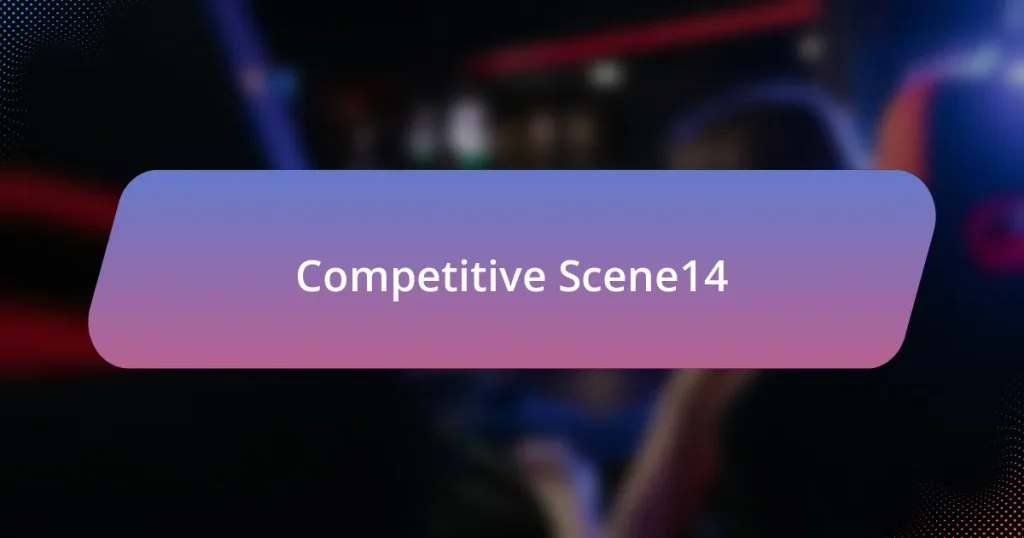The article provides a detailed comparison of the competitive scenes of Dota 2 and League of Legends, focusing on their key differences in game mechanics, tournament structures, and community engagement. It highlights how Dota 2’s complex gameplay and high-stakes tournaments like The International contrast with League of Legends’ structured meta and annual World Championship. Additionally, the article examines the unique features of each game’s gameplay, the characteristics of their player communities, and the economic aspects influencing their competitive landscapes, including sponsorships and prize pool distributions. Insights into future trends and best practices for player training in both games are also discussed, offering a comprehensive overview of the competitive dynamics within these two leading esports titles.

What are the key differences between Dota 2 and League of Legends in the competitive scene?
Dota 2 and League of Legends differ significantly in their competitive scenes primarily in terms of game mechanics, tournament structures, and community engagement. Dota 2 features a more complex gameplay with mechanics like denying, a shared pool of heroes, and the ability to influence the game through items and map control, which leads to a higher skill ceiling. In contrast, League of Legends emphasizes a more streamlined approach with distinct roles, a larger focus on team composition, and a more structured meta that evolves through patches.
Tournament structures also vary; Dota 2’s The International offers a massive prize pool funded by community contributions through the Battle Pass, which has historically reached over $40 million, while League of Legends has a more consistent annual circuit with regional leagues culminating in the World Championship, featuring a prize pool typically around $2 million.
Community engagement is another key difference; Dota 2’s community is often seen as more fragmented due to its reliance on individual skill and hero mastery, whereas League of Legends fosters a more cohesive community through its ranked system and regular updates that encourage player retention and engagement.
How do the game mechanics differ between Dota 2 and League of Legends?
Dota 2 and League of Legends differ significantly in their game mechanics, particularly in hero abilities, map design, and resource management. In Dota 2, heroes possess unique abilities that can be upgraded through items and levels, allowing for a high degree of customization and strategic depth. The map in Dota 2 features a day-night cycle, which affects visibility and certain abilities, while also allowing for more complex interactions with neutral creeps and objectives.
In contrast, League of Legends has a more streamlined approach to abilities, with champions having a set number of abilities that do not change throughout the match. The map design in League of Legends includes a more static environment with fewer neutral objectives that can be contested, focusing instead on lane dynamics and turret mechanics. Additionally, resource management in Dota 2 includes a gold system that allows for buying items at any time, while League of Legends has a recall mechanic that limits when players can return to base to purchase items.
These differences create distinct gameplay experiences, with Dota 2 emphasizing strategic depth and adaptability, while League of Legends focuses on fast-paced action and team coordination.
What unique features define the gameplay of Dota 2?
The unique features that define the gameplay of Dota 2 include its complex hero mechanics, the absence of a gold or experience cap, and the ability to deny allies’ creeps and towers. Dota 2’s gameplay is characterized by a diverse roster of over 120 heroes, each with unique abilities that require strategic synergy and teamwork. The lack of a cap on gold and experience allows players to accumulate resources indefinitely, promoting a dynamic and evolving game state. Additionally, the mechanic of denying, where players can attack their own creeps or structures to prevent opponents from gaining gold and experience, adds a layer of strategy not found in many other MOBAs. These features contribute to Dota 2’s depth and complexity, making it distinct within the competitive gaming landscape.
What unique features define the gameplay of League of Legends?
The unique features that define the gameplay of League of Legends include its champion diversity, strategic map control, and the importance of teamwork. League of Legends offers over 150 champions, each with distinct abilities and roles, allowing for varied gameplay styles and strategies. The game emphasizes map control through objectives like turrets, dragons, and Baron Nashor, which provide significant advantages when secured. Additionally, teamwork is crucial, as players must coordinate their efforts to execute strategies effectively, making communication and synergy vital for success. These elements collectively create a dynamic and competitive environment that distinguishes League of Legends from other multiplayer online battle arena games.
What are the major tournaments for Dota 2 and League of Legends?
The major tournaments for Dota 2 include The International, which is the game’s premier annual event featuring the highest prize pool, and the Dota Pro Circuit, which consists of various regional leagues and major tournaments. For League of Legends, the major tournaments are the League of Legends World Championship, known for its global competition and significant prize pool, and the Mid-Season Invitational, which showcases top teams from different regions. The International has consistently offered prize pools exceeding $40 million, while the League of Legends World Championship has drawn millions of viewers, highlighting the competitive significance of these events in their respective esports ecosystems.
How does The International impact Dota 2’s competitive landscape?
The International significantly shapes Dota 2’s competitive landscape by serving as the premier tournament that attracts top teams and players globally. This annual event not only offers the largest prize pool in esports history, often exceeding $40 million, but also establishes a benchmark for competitive play and team performance. The high stakes and visibility of The International incentivize teams to invest in player development and strategic innovation, thereby elevating the overall skill level within the Dota 2 community. Additionally, the tournament’s format and structure influence the competitive calendar, as teams prepare year-round to qualify, creating a robust ecosystem of regional leagues and qualifiers that feed into the event.
What role does the League of Legends World Championship play in its ecosystem?
The League of Legends World Championship serves as the pinnacle event in the League of Legends competitive ecosystem, showcasing the highest level of play and determining the world champion. This tournament not only generates significant viewership and engagement, with millions of fans tuning in globally, but also drives revenue through sponsorships, merchandise, and ticket sales. The event influences the game’s meta, as teams adapt strategies based on the competition, and it fosters community involvement through fan events and content creation. Additionally, the World Championship enhances the visibility of professional players and teams, contributing to the growth of esports as a legitimate career path.
How do player communities differ between Dota 2 and League of Legends?
Player communities for Dota 2 and League of Legends differ significantly in terms of culture, behavior, and engagement. Dota 2’s community tends to be more focused on strategy and teamwork, often emphasizing in-depth game knowledge and mechanics, which can lead to a more serious atmosphere. In contrast, League of Legends fosters a more casual and social environment, with a greater emphasis on individual performance and a vibrant community culture that includes memes and fan art.
Statistically, Dota 2 has a higher percentage of players who engage in competitive play, with around 30% participating in ranked matches, while League of Legends has a broader player base with over 100 million monthly active users, indicating a more extensive casual player community. Additionally, League of Legends has a more structured esports scene, which contributes to its community’s engagement through events and tournaments, whereas Dota 2’s community is often more fragmented, focusing on smaller, independent tournaments.
What are the characteristics of the Dota 2 player community?
The Dota 2 player community is characterized by its competitive nature, diverse player base, and strong emphasis on teamwork and strategy. Players often engage in intense competition, as evidenced by the high stakes of tournaments like The International, which has awarded over $40 million in prize money since its inception in 2011. This competitive spirit fosters a culture of skill development and mastery of complex game mechanics. Additionally, the community is known for its global reach, with millions of players from various backgrounds contributing to a rich tapestry of playstyles and strategies. The emphasis on teamwork is critical, as successful gameplay relies on effective communication and collaboration among team members, reflecting the game’s design that prioritizes cooperative play.
What are the characteristics of the League of Legends player community?
The League of Legends player community is characterized by its large, diverse, and competitive nature. This community consists of millions of players worldwide, with a significant presence in regions such as North America, Europe, and Asia, contributing to a vibrant ecosystem. The competitive aspect is highlighted by the existence of professional leagues, such as the League of Legends Championship Series (LCS) and the League of Legends European Championship (LEC), which attract substantial viewership and participation. Additionally, the community is known for its strong engagement on social media platforms and forums, where players discuss strategies, share content, and participate in events. The community also exhibits a mix of casual and hardcore players, with varying levels of commitment to the game, which influences the overall culture and interactions within the player base.

What are the economic aspects of the competitive scenes in Dota 2 and League of Legends?
The economic aspects of the competitive scenes in Dota 2 and League of Legends are characterized by significant prize pools, sponsorship deals, and revenue generation through in-game purchases. Dota 2 is known for its exceptionally high prize pools, particularly highlighted by The International, which has reached over $40 million in 2021, funded largely through crowdfunding via the sale of in-game items. In contrast, League of Legends generates substantial revenue through its franchise system, where teams pay for slots in regional leagues, and through consistent in-game purchases, contributing to a reported revenue of over $1.75 billion in 2020. Both games also benefit from sponsorships and advertising, with major brands investing heavily in team sponsorships and event promotions, further enhancing their economic viability.
How do sponsorships and partnerships influence both games?
Sponsorships and partnerships significantly influence both Dota 2 and League of Legends by providing financial support, enhancing visibility, and fostering community engagement. In Dota 2, for instance, major sponsors like Intel and Red Bull have contributed to the prize pool for The International, which has reached over $40 million, thereby attracting top talent and increasing viewership. Similarly, League of Legends benefits from partnerships with brands like Coca-Cola and Mastercard, which not only fund events but also integrate their products into the gaming experience, enhancing brand loyalty among players. These collaborations create a more robust competitive ecosystem, driving innovation and improving the overall quality of the games.
What types of sponsorships are common in Dota 2 tournaments?
Common types of sponsorships in Dota 2 tournaments include brand sponsorships, hardware sponsorships, and media partnerships. Brand sponsorships often involve companies like beverage brands or energy drinks that seek visibility through team logos and event branding. Hardware sponsorships typically feature gaming peripherals and equipment manufacturers, such as mouse and keyboard brands, providing products for players and promoting their brands during tournaments. Media partnerships involve streaming platforms and broadcasters that sponsor events to gain exclusive streaming rights, enhancing their visibility in the esports community. These sponsorship types are prevalent due to the high viewership and engagement levels associated with Dota 2 tournaments, which attract millions of viewers globally.
What types of sponsorships are common in League of Legends tournaments?
Common types of sponsorships in League of Legends tournaments include brand sponsorships, team sponsorships, and event sponsorships. Brand sponsorships often involve companies like hardware manufacturers, energy drinks, and gaming peripherals that seek visibility through tournament broadcasts and in-game advertisements. Team sponsorships typically feature organizations partnering with esports teams to promote their products, such as gaming chairs or software. Event sponsorships are usually from larger corporations that fund the tournament itself, gaining exposure through branding on promotional materials and live streams. These sponsorships are crucial for the financial viability of tournaments and help to enhance the overall viewing experience for fans.
What is the prize pool distribution like in both games?
The prize pool distribution in Dota 2 is significantly more top-heavy compared to League of Legends. In Dota 2, the majority of the prize pool is concentrated among the top teams, with the International tournament often featuring a prize pool exceeding $40 million, where the winning team can take home over $10 million. In contrast, League of Legends has a more balanced distribution, with its World Championship prize pool typically around $6 million, where the winning team receives a smaller percentage of the total prize pool, promoting wider financial rewards across more teams. This difference in distribution reflects the varying competitive structures and funding models of the two games.
How does Dota 2’s prize pool structure compare to League of Legends?
Dota 2’s prize pool structure is significantly different from League of Legends, primarily due to Dota 2’s reliance on crowdfunding through its Battle Pass system. In Dota 2, a substantial portion of the prize pool for The International, the game’s premier tournament, is generated from player purchases of the Battle Pass, which has led to prize pools exceeding $40 million in recent years. In contrast, League of Legends typically has a more stable and predictable prize pool funded directly by Riot Games, with annual championship prize pools around $6 million. This difference highlights Dota 2’s unique approach to prize funding, which can lead to extreme fluctuations in prize amounts, while League of Legends maintains a consistent financial model.
What factors contribute to the prize pool sizes in both games?
Prize pool sizes in Dota 2 and League of Legends are influenced by several key factors, including sponsorship deals, community contributions, and the overall popularity of the games. In Dota 2, the International tournament features a unique crowdfunding model where a percentage of in-game purchases contributes directly to the prize pool, resulting in record-breaking amounts; for instance, The International 2021 had a prize pool exceeding $40 million. In contrast, League of Legends relies heavily on corporate sponsorships and revenue from its franchise system, with major tournaments like the World Championship offering substantial prizes, such as the $6.45 million prize pool in 2021. These financial structures, along with the games’ respective player bases and viewership numbers, significantly impact the overall prize pool sizes.

What are the future trends in the competitive scenes of Dota 2 and League of Legends?
The future trends in the competitive scenes of Dota 2 and League of Legends indicate a shift towards increased integration of esports with mainstream entertainment and enhanced viewer engagement. Dota 2 is likely to continue its trend of large-scale international tournaments, such as The International, which has consistently seen prize pools exceeding $30 million, driven by community funding through the Battle Pass system. Meanwhile, League of Legends is expected to expand its franchising model, which has already proven successful in regions like North America and Europe, fostering stable team investments and consistent competition schedules. Both games are also anticipated to leverage advancements in technology, such as augmented reality and virtual reality, to enhance the spectator experience, as evidenced by Riot Games’ ongoing experiments with immersive viewing options.
How are player contracts evolving in both games?
Player contracts in both Dota 2 and League of Legends are evolving towards greater player autonomy and financial security. In Dota 2, the introduction of the Dota Pro Circuit has led to more structured contracts that often include performance-based incentives, reflecting the competitive landscape’s demand for consistent results. Similarly, League of Legends has seen teams offering longer-term contracts with guaranteed salaries, which provide players with stability and the ability to focus on performance without financial stress. This shift is supported by the increasing revenue from sponsorships and media rights, allowing organizations to invest more in player welfare and contract terms.
What changes are being seen in Dota 2 player contracts?
Recent changes in Dota 2 player contracts include a shift towards more flexible terms and increased player autonomy. This evolution reflects a growing trend in the esports industry where players are negotiating contracts that allow for greater freedom in team selection and sponsorship opportunities. For instance, many contracts now include clauses that enable players to explore external partnerships without penalty, which contrasts with traditional contracts that often restricted such activities. Additionally, the rise of player unions and advocacy groups has led to more standardized contract terms, ensuring fairer compensation and working conditions for players.
What changes are being seen in League of Legends player contracts?
Recent changes in League of Legends player contracts include increased salary transparency and the introduction of performance-based incentives. Teams are now more openly discussing player salaries, which has led to a more competitive market. Additionally, contracts are increasingly incorporating clauses that reward players for achieving specific performance metrics, such as tournament placements or individual statistics. This shift reflects a broader trend in esports towards valuing player contributions and fostering a more meritocratic environment.
What innovations are being introduced in tournament formats?
Innovations in tournament formats include the introduction of flexible scheduling, online qualifiers, and hybrid formats that combine both online and offline play. These changes aim to enhance accessibility for teams and players, allowing for a broader range of participation. For instance, the use of online qualifiers has expanded the pool of competitors, enabling teams from various regions to compete without the need for travel, which was highlighted in the 2021 Dota 2 International qualifiers. Additionally, hybrid formats have been successfully implemented in events like the League of Legends World Championship, where initial rounds are held online, followed by a live event, thus optimizing both viewer engagement and logistical efficiency.
How is Dota 2 adapting its tournament formats for future growth?
Dota 2 is adapting its tournament formats for future growth by implementing a more flexible scheduling system and diversifying the types of events. This includes the introduction of regional leagues, which allow for more consistent competition and engagement among local teams, as seen with the Dota Pro Circuit. Additionally, Dota 2 has been focusing on enhancing viewer experience through innovative broadcasting techniques and interactive features, which aim to attract a broader audience. The success of The International, which has consistently broken prize pool records, demonstrates the effectiveness of these adaptations in fostering community support and increasing overall participation in the competitive scene.
How is League of Legends adapting its tournament formats for future growth?
League of Legends is adapting its tournament formats for future growth by implementing a more flexible scheduling system and enhancing regional leagues. The introduction of the League of Legends Championship Series (LCS) and League of Legends European Championship (LEC) has allowed for a more structured approach to competitive play, enabling teams to compete in a more organized environment. Additionally, Riot Games has focused on expanding the accessibility of tournaments through online qualifiers and localized events, which increases participation and viewership. This strategy is supported by the growing global audience, as the game has consistently ranked among the most-watched esports titles, with millions of viewers tuning in for major events like the World Championship.
What strategies can players adopt to succeed in the competitive scenes of Dota 2 and League of Legends?
Players can adopt several strategies to succeed in the competitive scenes of Dota 2 and League of Legends, including mastering game mechanics, effective communication, and strategic teamwork. Mastering game mechanics involves understanding champion or hero abilities, item builds, and map awareness, which are crucial for maximizing individual performance. Effective communication among team members enhances coordination during matches, allowing for better decision-making and execution of strategies. Strategic teamwork focuses on roles and synergy, where players must understand their specific responsibilities and how they complement each other, leading to more cohesive gameplay. Historical data shows that teams with high communication and synergy often outperform those with less coordination, as seen in tournaments where top teams consistently demonstrate these traits.
What are the best practices for training in Dota 2?
The best practices for training in Dota 2 include focusing on individual skill improvement, team coordination, and strategic understanding. Players should dedicate time to mastering a diverse hero pool to adapt to various game situations, while also practicing last-hitting and map awareness to enhance their overall gameplay. Regularly reviewing replays helps identify mistakes and improve decision-making. Additionally, participating in scrims with other teams fosters teamwork and communication skills, which are crucial for success in competitive matches. These practices are supported by the fact that professional players often emphasize the importance of consistent practice and analysis to maintain a competitive edge.
What are the best practices for training in League of Legends?
The best practices for training in League of Legends include focused practice on specific skills, regular review of gameplay, and effective communication with teammates. Focused practice involves dedicating time to mastering individual champions, understanding their mechanics, and learning optimal builds. Regularly reviewing gameplay through replays helps identify mistakes and areas for improvement, allowing players to adjust their strategies. Effective communication with teammates enhances coordination and teamwork, which are crucial for success in competitive matches. These practices are supported by the fact that professional players often emphasize the importance of skill refinement and teamwork in their training regimens.













